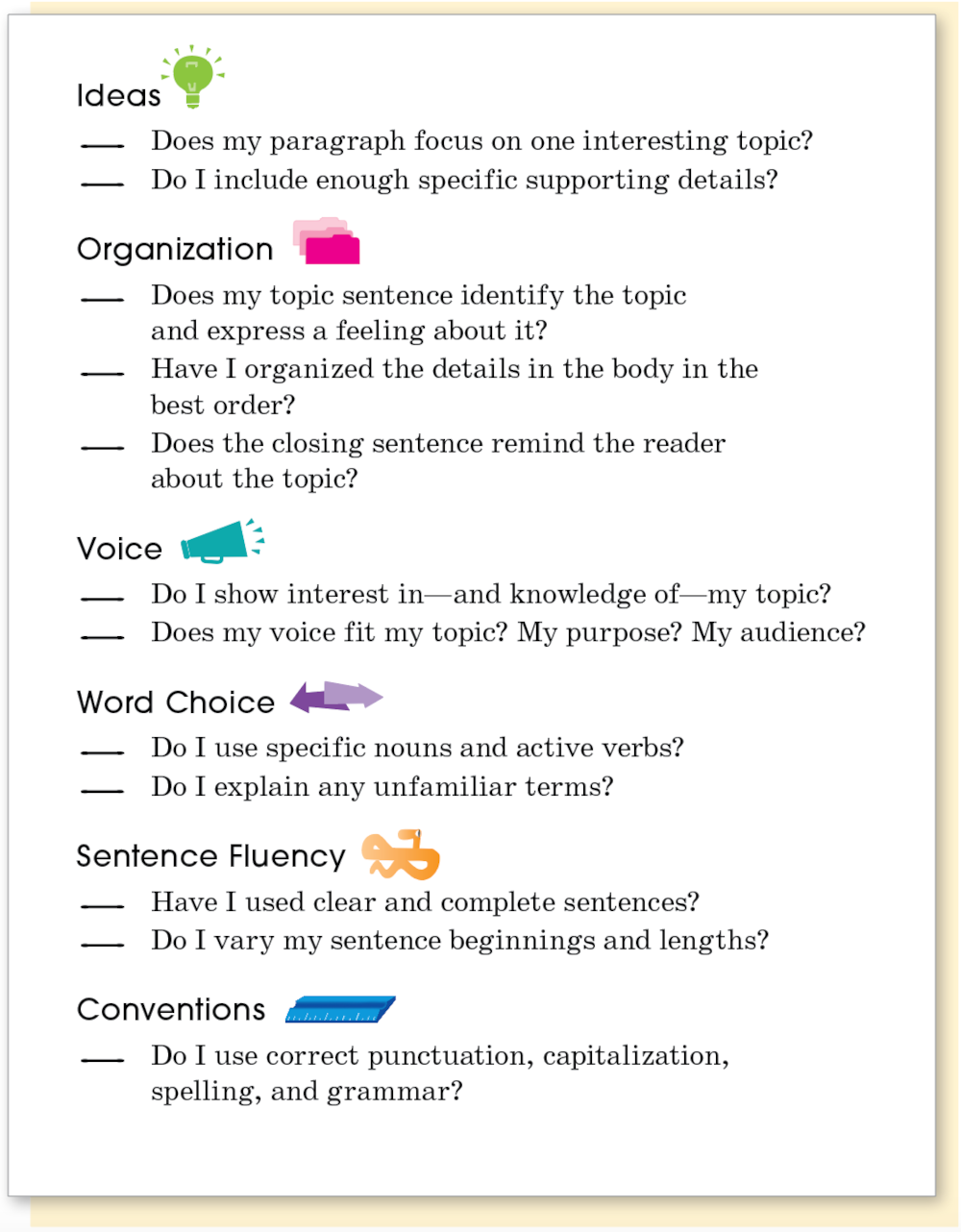WOC 091
Page 91
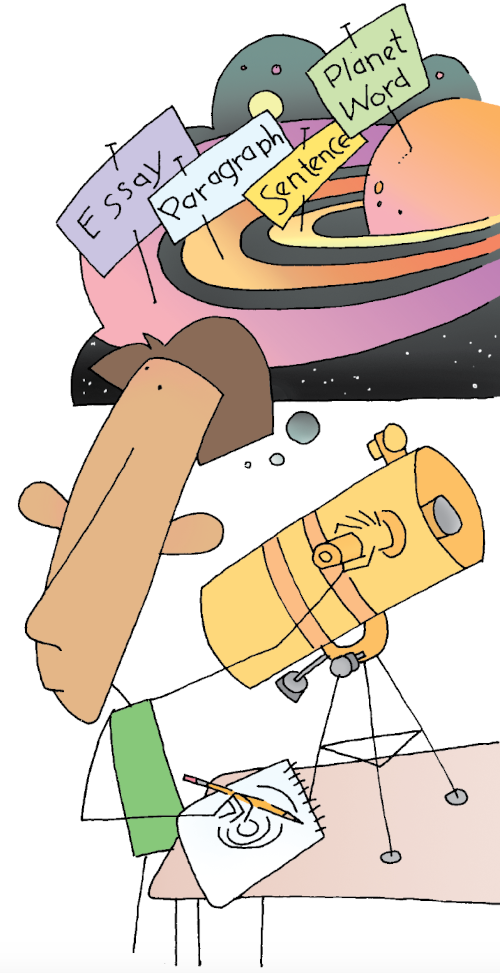
Building Paragraphs
Think of language as a series of concentric rings around Planet Word. Words are the core element of the language: With them, we form sentences; then with sentences, we form paragraphs; and with paragraphs, we form essays.
This illustration helps you see how paragraphs fit into the scheme of things. They are more developed than sentences, but less than essays and reports. Writer Donald Hall rightly identifies paragraphs as both “maxi-sentences” and “mini-essays.” In this chapter, you will learn how to write strong paragraphs, a skill that will help you with all of your academic writing.
What’s Ahead
WOC 092
Page 92
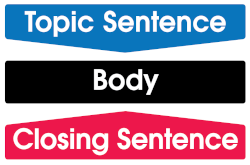
The Parts of a Paragraph
Most paragraphs begin with a topic sentence that states the topic of the writing. The sentences in the body of the paragraph support or explain the topic, while the closing sentence brings the paragraph to a logical finish.
Walking London
Topic Sentence If you ever get to visit London, England, go for a walk. When you jump on the Tube (the subway), you get quickly from place to place, but you miss everywhere in between. BodyInstead, start at historic Victoria Station and walk 10 minutes up the road to Buckingham Palace, where the king resides. Then meander through St. James Park on your way to majestic Westminster Abbey. It holds graves of kings and greats like Sir Isaac Newton. Afterward, pass Big Ben and the Houses of Parliament and hike up Whitehall. You’ll see 10 Downing Street, where the Prime Minister lives. Then go on to Trafalgar Square and the National Gallery. Head east along the Thames to find an 1,800-year old Roman wall and the Tower of London, the 1,000-year-old castle prison. Cross the famed Tower Bridge and walk past the Shard skyscraper to reach the Globe Theatre, a reproduction of Shakespeare’s own. End your walking tour with a ride on the London Eye, a giant Ferris Wheel. Closing Sentence The best tour of London immerses you in the city, step by step.
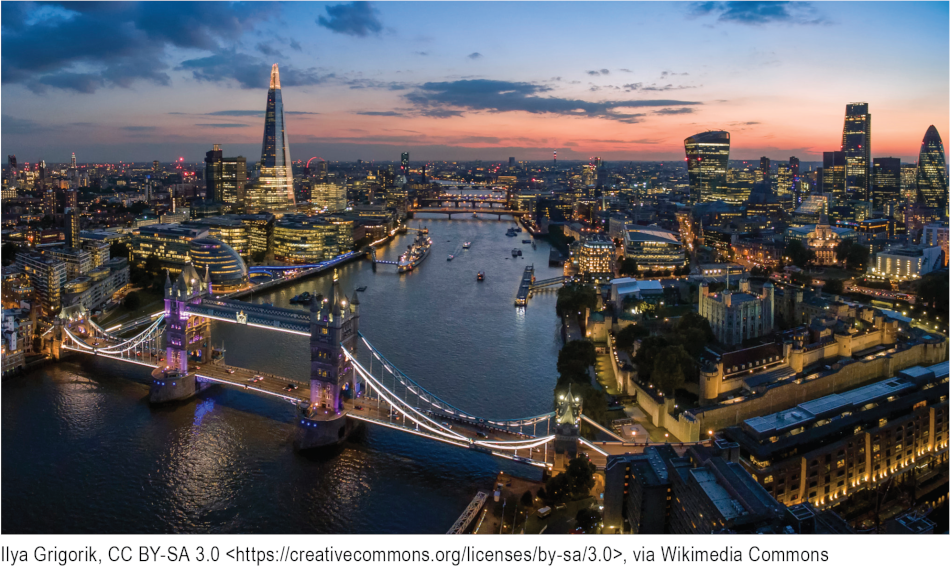
WOC 093
Page 93
A Closer Look at the Parts
Topic Sentence
The topic sentence tells your reader what the paragraph is about. It also helps you keep your writing under control. Here is a formula for writing good topic sentences.

Helpful Hint
A sentence like "Walking around London is good" would not make a strong topic sentence because it does not express a specific focus about the topic.
Body
The body is the main part of the paragraph. The sentences in the body should include specific details that support the topic sentence. You can use facts, statistics, reasons, examples, quotations, sensory descriptions, and so on. (See page 44.) They can come from your personal knowledge of the topic or from other sources.
Organize your details so that the reader can easily follow them. The details in “Walking London” follow spatial organization, letting the walking path unfold, location by location.
Closing Sentence
The closing sentence wraps up the paragraph. It summarizes the ideas you have presented and provides the reader a strong thought to take away.

WOC 094
Page 94
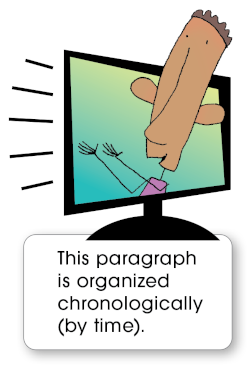
Types of Paragraphs
There are four basic types of paragraphs: narrative, descriptive, explanatory, and persuasive (argument). Each one requires a different kind of thinking and planning.
Narrative Paragraph
A narrative paragraph tells the story of a memorable event or experience. The details in a narrative paragraph should answer the 5 W’s (who? what? when? where? and why?) about your topic.
Breakdown
Topic Sentence Last summer, my Grandpa Frank and I were riding the Greyhound from Joliet to Bloomington, Illinois, when smoke started pouring out of the engine. Body The driver pulled over in the middle of nowhere and climbed out to check the engine. Most of the other riders groaned and pulled out their phones, but Grandpa got up to see what was happening. I followed. We piled out of the bus to find the driver fanning smoke away from the engine. He said he’d called for another bus, but it would be an hour at least before it arrived. Grandpa started talking to the driver, and we found out he was Ramon from Mexico City. He told us all about growing up there and about his home and family. Ramon even invited us to come visit him. The replacement bus eventually arrived, and we got underway. Everybody else hated that breakdown. Closing Sentence But thanks to Grandpa, I didn’t scroll away an hour on my phone; instead I made a new friend.
Good Thinking
Strong narratives use specific nouns and active verbs to help you picture the action: “smoke started pouring out,” “riders groaned,” “We piled out,” “driver fanning smoke away,” . . .
WOC 095
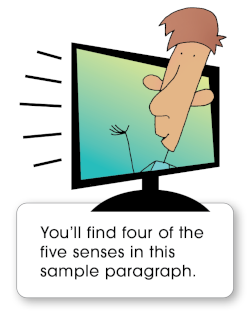
Page 95
Descriptive Paragraph
A descriptive paragraph gives a clear, detailed picture of a person, a place, a thing, or an event. Descriptive paragraphs often contain many sensory details (sight, sound, smell, taste, and touch sensations).
When a Perfect Day Is Done
Topic Sentence Mom and I had had a perfect day at the Indiana Dunes, but now it was ending. Body Beyond Lake Michigan, a tattered blanket of blue-gray cloud was unfurling over the skyline of Chicago. The sun sank behind the webwork of cloud, sometimes vanishing, sometimes peering golden through a space, sometimes glowing pink through cloud. Mom and I sat on our sand-crusted towels, watching the light show as we distractedly nibbled our roast beef subs and Sun Chips. I wished this moment would last forever. The sun ducked behind a cloud, and a cold shadow swept across the beach. My sunburned shoulders shivered. Then the sun emerged again—low, red, and swollen as it nestled down amid the skyscrapers. It seemed to flatten, sending up purple rills of cloud. Then it sank below the city and was gone. I felt sad. But then I heard applause. Closing Sentence I looked around, and the other people on the beach were giving the sunset a standing ovation.
Helpful Hint
This paragraph describes an event, so it uses both spatial and chronological organization: “The sun sank behind the webwork of cloud, sometimes vanishing, sometimes peering through a space, sometimes glowing pink through cloud.”
WOC 096
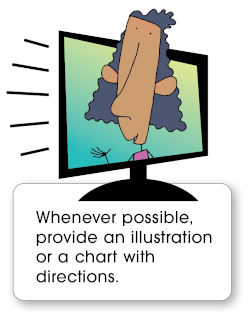
Page 96
Explanatory Paragraph
An explanatory paragraph informs or explains. Explanatory writing shares information about a topic, gives directions, or shows how to do something.
Chopsticks Primer
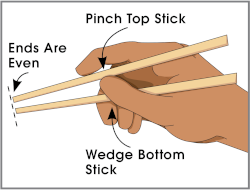
Topic Sentence Chopsticks are the preferred eating utensils in many Asian cultures. The origin of chopsticks goes back 5,000 years, when men in China would use small sticks or branches to retrieve meat from fires. Body Later, the Chinese philosopher Confucius called chopsticks the most moral eating utensils, because an “honorable and upright man allows no knives on his table.” To use chopsticks, position the first stick so that the thicker part rests at the base of your thumb, and the thinner part rests on the underside of the middle fingertip. In the same hand, hold the other chopstick as you would a pencil. Then place pressure on the top chopstick so that it pivots (moves) on your index finger and thumb. This will make the tips of the sticks touch each other. Next, repeat this motion to pick up rice or noodles. Closing Sentence Eating with chopsticks will seem awkward at first, but with a little practice you will enjoy using them.
WOC 097
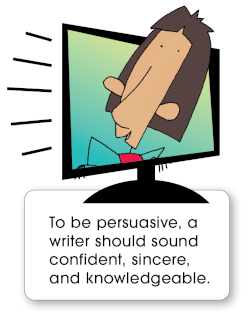
Page 97
Persuasive (Argument) Paragraph
A persuasive paragraph presents an opinion (or a strong feeling) about a topic. An effective persuasive paragraph convinces the reader to agree or to do something.
Save Mill Lake
Topic Sentence The Department of Natural Resources say the Mill Lake dam could not withstand a 100-year flood, so we must remove it or replace it. Body Some favor removal, saying dams destroy ecosystems. But a dam has been on this site since the founding of our city in 1835. For nearly 200 years, the dam has created not only Mill Lake but many wetland ecosystems that are homes to egrets, cranes, mergansers, and other waterfowl. Beavers rely on the estuary creeks for their own dams and ponds. Removing the human dam would destroy all these ecosystems. I, too, am a creature who needs the lake and the wetlands. I grew up playing in Mill Lake Park, boating and fishing on the lake and the river, catching tadpoles in the shallows—being a kid. We already have two other rivers in our city, and converting the lake back to a river would be a loss for all of us. Closing Sentence So in the coming referendum, vote to Save Mill Lake.
Good Thinking
A good thinker is able to counter, or logically respond to, an opposing viewpoint. This writer presents the opposing viewpoint in the second sentence and counters with the rest of the paragraph.
WOC 098
Page 98
Writing Guidelines
Remember that a paragraph focuses on one specific topic that can be developed in the form of a narrative, a description, an explanation, or an opinion. To be effective, a paragraph must give the reader a clear and interesting picture of the topic. Use the guidelines that follow to help you write paragraphs.
Prewriting ■ Choosing a Topic
- Explore the general subject area provided by your teacher. (See pages 32–33 for selecting strategies.)
- Select a specific topic that truly interests you and meets the requirements of the assignment.
Gathering Details
- Collect facts, examples, and ideas about your topic.
- Write a topic sentence that expresses a specific feeling about the topic of your paragraph. (See page 93.)
- Plan the rest of the paragraph. Which details will you include? How will you organize them?
Writing ■ Creating the First Draft
- Start your paragraph with the topic sentence, which tells the reader what your paragraph is about.
- Follow with sentences that support your topic with interesting details. Arrange these sentences in the best order.
- Use transitions, when needed, to connect your ideas. (See page 101.)
- End with a sentence that reminds the reader about the topic or provides a final thought.
Revising ■ and Editing ■ Improving the Writing
- Add information if you need to say more about the topic.
- Cut unimportant details. (See page 99.)
- Rewrite any unclear or incomplete sentences; move any that are out of order.
- Check your revised writing for conventions.
- Write a neat final copy of your paragraph and proofread it.
WOC 099
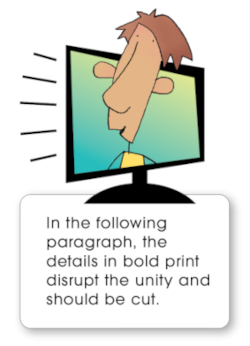
Page 99
Creating Unity
In a well-written paragraph, each detail supports the topic. If a detail does not tell something about the topic, it breaks the unity of the paragraph.
Yellowstone
Topic Sentence The world’s oldest national park covers nearly 3,500 square miles and straddles a supervolcano. Body A huge magma chamber under Yellowstone National Park provides the geothermal energy that fuels the park’s major features. Surface water drains into subterranean chambers that boil and erupt, sending steaming geysers shooting skyward. Hot spring pools paint themselves with hues of blue and orange and red. People who wander off the boardwalks risk injury or death. Bubbling mud pots create gurgling cauldrons that smell of sulfur. Let’s not forget Yellowstone’s other natural wonders—the Yellowstone River and Lake, the Grand Canyon of Yellowstone, 3,500 waterfalls, and 1,000 miles of hiking trails across many rugged peaks. This dramatic landscape hosts bison, elk, deer, grizzlies, wolves, beavers, porcupines, and hundreds of bird species. They have gift shops with mugs and shirts and trinkets that show these animals. Closing Sentence It's little wonder that President Teddy Roosevelt chose this land as the first National Park, and thereby began an international movement to preserve wild spaces.
Helpful Hint
A unified paragraph forms a meaningful whole. All of the information follows logically and supports the topic sentence.
WOC 100
Page 100
Establishing Coherence
A strong paragraph reads smoothly from start to finish. A paragraph has coherence when all of the details are effectively tied together. One way to make your writing coherent is to use transitions. In the following paragraph, the underlined transitions help tie the details together.
A Capital Adventure
Topic Sentence I had been dreading the 8th grade trip to Washington, D.C., thinking it would be boring history, but I was wrong. Body When we climbed the steps to the Lincoln Memorial, I suddenly was standing on a stone that marked where Dr. Martin Luther King, Jr., gave his “I Have a Dream” speech. I got goosebumps. Turning around, I gazed down at the Reflecting Pool reaching to the World War II Memorial. Beyond I could see the Washington Monument and, at the far end of the Mall, the Capitol Building. To the left stood the White House, built first by President Washington and lived in by every president since. When I turned back around and walked farther up, suddenly there was President Lincoln in white marble, 19 feet tall while seated. I read his words on the walls, and later that day read MLK’s words at his memorial. Both men fought for the freedom of all people. The next day, we rode a huge elevator down to the bottom floor of the National Museum of African American History and Culture. As we slowly wound upward from darkness to light, I started to understand what that fight for freedom was all about. Yes, Washington, D.C., is full of history, but when you walk through it, history is now. Closing Sentence I saw things in Washington that changed my eyes, so when I came back, not only history but also everything else looked different.
Good Thinking
Use your best judgment with transitions. Writing that contains too many of them may sound awkward or unnatural. The selective, and effective, use of transitions should be your goal.
WOC 101
Page 101
Using Transitions
Transitions connect one sentence to another or one paragraph to another within an essay or a report. The chart below lists types of transitional words and phrases.
Transitional Words and Phrases
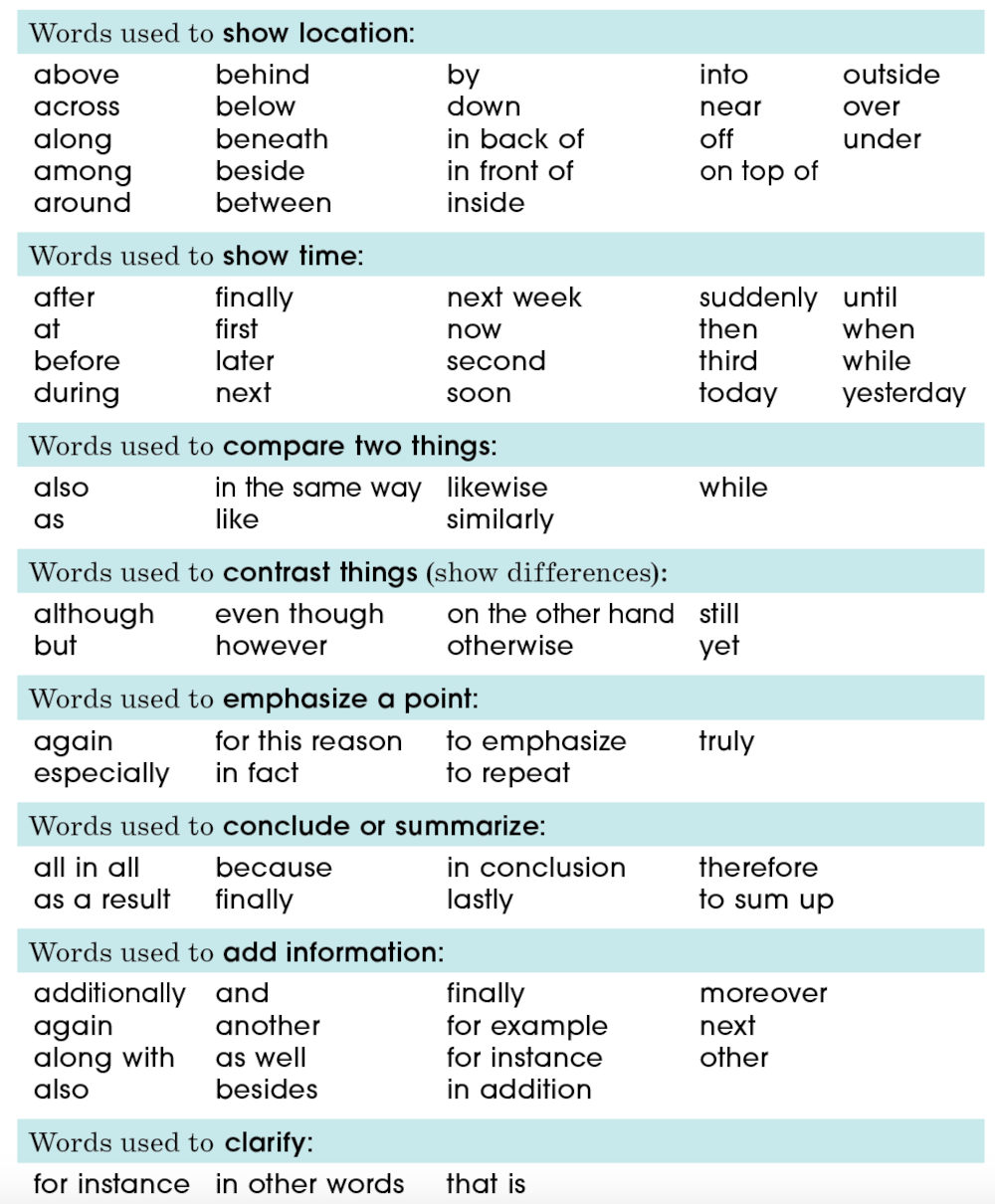
WOC 102
Page 102
Paragraph Checklist
Use this paragraph checklist as a guide when you revise and edit your paragraphs.
Paragraph Checklist
